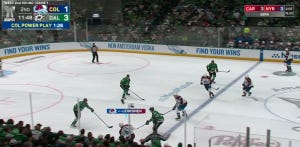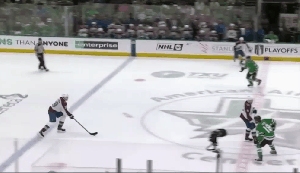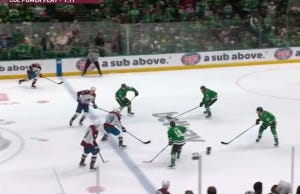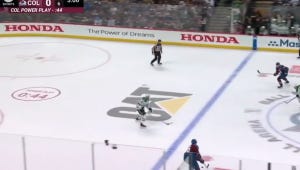Breaking Down How the Dallas Stars Tweaked Their Penalty Kill against the Colorado Avalanche
You’ve surely heard by now, but Peter DeBoer admitted to making some adjustments to their penalty kill after Game 1, in which Dallas surrendered two power play goals to Colorado. Of course, he isn’t going to say what those have been, but I love things like this, even when the coach might be totally full of it. Is there a change that was made, and has Colorado simply failed to adjust? Or is it just a matter of execution, and DeBoer is trying to mess with Jared Bednar’s head?
Well, I was curious. So I went back and watched every Colorado power play in this series so far to see what both teams are trying to do, and I think I have some inkling of what’s changed. Also it was really fun, so I figured I’d put a few dozen screenshots and GIFs up here and let y’all have a gander. This may not be heavy-duty analysis, but it’s also more attention to detail than I usually have the time or inclination to give posts like this. But this is my website on the internet, and it’s free, so I figured I might as well throw everything up here for y’all to see. Come along with me and see how the Stars have outfoxed the Avalanche in yet another area of the ice.
***
Game 1: Colorado goes 2-for-2 on the power play
From Game 1, here’s the first Avalanche power play.
You can see Dallas set up in a 1-2-1 sort of diamond, although there’s not too much to be gleaned from this one, as Johnston’s stick broke right off the faceoff, putting Dallas immediately in trouble. Makar actually flubbed a pass back to MacKinnon here, then ended up just bypassing the helpless Johnston, before putting a puck off Oettinger that Suter can’t quite grab before Makar follows up to bump it over towards Nichushkin, who was in the perfect spot to put the puck home.
Not that bad, really. Broken plays are always difficult on a defense, and the Avs took it to the house here. Let’s look at the second (and only other) Colorado power play.
The entry is interesting here, as Cale Makar just takes what he’s given and crosses the blue line, eschewing the drop pass (which you can see Jamie Benn was guarding at center ice). Makar rimmed it around, but the Stars quickly cleared.
Take two:
MacKinnon and Lehkonen combine for a quick entry this time, with Lehkonen driving deep along the wall before bumping the puck back to the point, where Colorado finally gets set up:
Again, you see the common PK formation: F1 is high, but will exchange with F2 or one of the D-men if the puck dictates it. Which player is closest to the puck carrier steps up to pressure, though never overextending unless there’s a true chance for a turnover.
You can see Johnston has taken over at the point now, with Benn having followed the puck along the half-wall previously before exchanging with Lindell, who is pressuring Rantanen. Tanev has falled at the net, but he’ll get back up before the puck makes it towards Oettinger.
That sequence led to a dangerous chance that Oettinger eventually stopped, but you can see how Dallas is forcing Colorado to make some 50/50 passes that could get intercepted, or to simply throw it towards the net and hope for the best.
The problem comes after Roope Hintz’s failed rush on the next sequence, though. He loses the puck after curling back, and the Avalanche get a free zone entry, leading to the PK unit being far too compressed. F1 isn’t able to recover in time to pressure Makar, and he steps up and rips it past Oettinger.
Oettinger will say he should save that, and I suppose so. But Makar has one of the best shots of any defenseman in the game, and this puck takes off into the top shelf faster than you’d expect:
Every camera angle of Cale Makar's goal is uniquely beautiful. https://t.co/Erjz5QvxoF pic.twitter.com/pw0D0AEApS
— Avalanche Forever (@citchmook) May 9, 2024
***
Game 2: Colorado goes 0-for-3
Okay, so you’ve seen the basics. Dallas is trying to prevent the drop pass that freezes their defenders on the blue line, forcing Colorado to enter the zone under pressure and dump the puck in, leading to battles along the wall that Dallas might be able to win in order to clear. There’s more going on, of course, but let’s accept that part of the premise and look at Game 2:
Late in the first period, Mason Marchment takes a silly drive-by penalty, and Colorado wins the faceoff. But Dallas’ F1 Johnston pressures quickly:
Makar is forced to dump the puck down to the corner to avoid a risky turnover to Johnston, and Lindell smartly gets to the puck first, leading to a Dallas clear:
Nothing too complicated there. Great pressure by Johnston, good work along the boards, and the puck gets cleared.
On the follow-up entry, you’ll notice both Dallas forwards heavily involved in pressuring in the neutral zone. This slows Colorado down a bit with some cross-ice passing in their zone before MacKinnon tries something few forwards would dare, taking it into the teeth of the penalty kill:
Notice what happens here: Wyatt Johnston makes a perfect read, putting his stick down like he’s protecting a cross-crease pass. He knows exactly what MacKinnon is planning to do, and puts his stick on the ice to block it. Boom, another clear. Johnston is 20 years old, and he’s already played a huge role in foiling Cale Makar and Nathan MacKinnon on this power play. You literally cannot (Literally!) say enough about this player.
The Avs make another effort to enter the zone, with Hintz as F1, and the F2 Tyler Seguin nearly knocking the puck off MacKinnon’s stick:
He doesn’t quite get it, and MacKinnon ends up making it in this time for Colorado to get set up. But still, he had to take a decent-sized risk to do it, which is one of Dallas’s strategies right now. They’re not quite standing up at the blue line so much as forcing Colorado into tough decisions in areas with serious ramifications.
Anyway, Colorado gets set up, and Dallas once against pressures the puck-carrier hard, rather than collapsing and giving Makar and company space up high to work with:
Obviously this can open up space in the slot if you’re quick enough, but Dallas knows that, and defensemen will jump up if needed. Instead, Hintz wraps up Lehkonen along the wall, and the puck gets fed back to Makar, who throws a shot at Oettinger with MacKinnon on his lap:
This is the risky side of hard pressuring on the PK. If the power play makes the right passes, lanes open up in a hurry.
Personally, I think Makar would probably choose to go wide to Rantanen next time if he had a do-over, but time is winding down, so he may be making a choice between the good and the perfect here. Either way, the puck bounces away harmlessly.
At the start of the second period, Makar is once again forced into trying to be a superstar to make an entry successfully, but he does so without enough support for Colorado to really get set up before Dallas wins a puck and clears it again.
After the Stars score a power play goal of their own to go up 3-0, the Avs get back on the job thanks to an iffy call on Hintz. Johnston once against pressures Makar at the point, and he once again has no choice but to throw the puck into a suboptimal area:
Tanev almost collected the shot-pass down low, but Colorado collects again, with MacKinnon then sucking in Johnston before making a pretty backhand feed to Makar, who steps into the open slot just like he did in the prior game:
This is the sort of chance Dallas doesn’t want to keep allowing. However, Oettinger doesn’t get beat this time (the puck may not have gotten through at all), and the Stars end up clearing.
MacKinnon collects a loose puck in the neutral zone again to enter with a sort of 3-on-2 that he takes down low, which turns into this:
Notice how Tanev is jumping up with Johnston to double-team MacKinnon in hopes of turning over the puck. When people talk about “aggressive penalty kills,” this is the sort of thing they mean. MacKinnon barely gets the puck away, trying to feed Nichushkin in the trapezoid, but the puck heads along the boards, and the Stars battle with Colorado for a bit before Sam Steel eventually clears it. It’s a risk initially, but Lindell and Tanev have been dynamite in their board work, and the Stars clearly want to do everything they can to keep the puck out there and pressure it the moment they can rather than chase passes around their 1-2-1.
Notably, the Avs keep their top guys on the ice for this power play as it rolls on. That’s been a trend all series, with the top dogs for Colorado playing 1:30 out of every 2:00 each power play, by the way:
Anyway, on the second half of the advantage, MacKinnon sees both Dallas forwards standing relatively still after the drop pass, and he attacks the zone and enters successfully:
The puck goes low-high back to Makar, who then feeds the far side for a dangerous chance with traffic:
Dallas survives it, barely. But it’s an example of what can happen if your PK gets caught standing still against this power play. They’re strong and fast and deadly, as Dallas found out in Game 1. However, the danger on this power play ended up residing in an unexpected place: the penalty kill.
You see, Val Nichushkin made a bad play here, and the Stars’ F1 (Jamie Benn) pressured him at the blue line, which led to this chance. Note the three Colorado forwards standing straight-legged at the circles, watching the 3-on-1 develop without a prayer of helping out:
Tyler Seguin is on the board with a shorthanded goal. pic.twitter.com/xFDrwh3AwT
— Sportsnet (@Sportsnet) May 10, 2024
This is another side of Colorado’s overuse of their top guys. Note the timestamps from the prior screenshot to the one below.
Yep, ten seconds elapsed from the turnover to Seguin’s goal, but Rantanen was the only one of those three forwards to even get back in time for a token effort. That’s why Seguin was so open for that crazy rebound chance. It’s almost like there’s a price to be paid for asking four players to win games for you every night, eh?
Anyway, this also ended up being the game-winning goal. Maybe that’s something for the Avalanche to think about.
Finally, the Avs ended up getting a massive power play with three minutes to go, right after drawing within a single goal. You’d expect Dallas to be rattled and tentative, but check this out:
Yep, that’s both Seguin and Tanev(!) pressuring hard at the blue line, totally giving up the numerical advantage down low. They’re daring Colorado to try to make a play, but all that ends up happening is a hopeful wrist shot that rebounds to Tanev for a clear:
As for the next entry, it was a missed pass fought for along the boards before an Esa Lindell clear. Simple stuff. Finally, with Colorado getting ready to pull Georgiev for the 6-on-4, MacKinnon once again goes up the guts of the ice, leading to a dicey entry that Colorado manages to collect.
And it works, insofar as Colorado gets that killer chance they want. Rantanen sees a tiny seam, but he makes the pass to MacKinnon, waiting at the circle to dash Dallas’s dreams for the second game in a row:
But the puck bounces past MacKinnon, who may not have been ready for the pace of the pass. Or perhaps it was deflected on its way over. Regardless, Colorado had a shining moment, but they stumbled. That happens sometimes.
Colorado would get another look or two, but nothing quite of that caliber. They also came from a 6-on-5 set, which isn’t really what we’re here to talk about, so let’s move on. I believe Dallas won Game 2 though, if you’re wondering.
***
Game 3: Colorado goes 0-for-3, again
Thus far, we can already see a couple of small tweaks, or at least things Dallas is doing more successfully since Game 1: they’re pressuring the puck hard, they’re trying to prevent the drop pass from freezing them at the blue line, and they’re offering the easiest entries into the middle of the ice, where they can immediately close on the puck carrier and force a turnover, or at least a puck battle along the boards.
Early in this one, Dallas got called for too many men on the ice, which I assume was some sort of homage to the Avalanche in the prior game. Regardless, Colorado started off by clearing the puck themselves after a faceoff win (they have won a lot of power play faceoffs), but Makar made a nice play in the neutral zone to slow down the forecheckers, allowing Lehkonen to gain the zone and send a simple backhand along the boards to the point:
That would lead directly to the incredible Chris Tanev block on MacKinnon, by the way:
This goes to show that Dallas isn’t completely preventing any and all chances, by the way. Jake Oettinger and his merry men have had to perform heroics, and they’ve done so. This is playoff hockey at its absolute best, and I love it. Also, it is probably killing me.
Again, Colorado left its top guys out there for a solid minute, and again, Dallas got a shorthanded rush. It started when Makar carved up F1 and F2 to gain the blue line with MacKinnon:
And then Lehkonen couldn’t corral a cross-ice pass in his skates…
…which led to a Jamie Benn rush that he didn’t convert with his default five-hole attempt. Still, it was yet another chance surrendered by a Colorado power play that feels the pressure to win games all on its own.
After that, the second power play unit came on, and Dallas weather some direct-but-not-dangerous moments.
Later in the same period, Colorado got their second power play, wins the faceoff, and once again, Dallas’s F1 (Seguin) pressures them (Rantanen) before they can get set up, leading to a clear:
By the way, Tyler Seguin has probably been Dallas’s best player this series. Just something that makes me happy. Anyway, Roope Hintz pressures well enough in the neutral zone to corral the puck carrier to the wall, where Dallas is well-prepared for the entry attempt, which Hintz is about to clear in the below screenshot:
On Colorado’s third attempt to set up, Lehkonen gets the puck along the boards, but instead of backhanding it back to the point as he did on the first power play—which worked great, by the way!—he waits to draw in a Dallas player…
…and then promptly splits the players on the point to clear it himself. Whoops.
On try #4, Makar finally gets fed up and tries to go up the center of the ice himself, once again without adequate support:
This once again leads to an easy clear for Dallas, as you’d expect. These signs of frustration often showed up on the bench as well, as you probably noticed on the broadcast. The psychological impact of a successful penalty kill is a weapon in and of itself.
At last, on their fifth try, Colorado gains the zone with a quick up to MacKinnon in the neutral zone that beats the first forward.
But fatigue may be setting in, because the setup fizzles when a pass back to MacKinnon rides the dasher and gets cleared by Benn. But unfortunately, Benn’s pass on the ensuing rush gets taken by Nichushkin immediately, and he sends it right back down the ice for a 2-on-1 that only a Ryan Suter cleanup prevents from turning into a goal:
The second unit for Colorado finished that power play, but it was interesting to note that Dallas doesn’t appear to pressure as aggressively with Sam Girard, Zach Parise & Company out there. Presumably because it is Sam Girard and Zach Parise and Company out there. Perhaps it was just a quirk of that one expiring power play, but it’s something to watch, in the rare event that Colorado’s second power play unit ever shows up again:
Finally, Colorado got their third straight power play with just a few seconds remaining in the first period, and Chris Tanev stepped up to block yet another MacKinnon effort:
In the second period, MacKinnon again gained the zone by going right into the maw of the PK unit.
The puck would get swept to the corner, but this was a battle Colorado would win, and the puck came back up high to Makar, who this time did go for Rantanen at the side of the net, only for Rantanen to send the puck high and wide.
The rebound would get collected by Steel, sending Johnston in for a half-decent shot on Georgiev, by the way:
Dallas almost regained the puck in the neutral zone afterwards, but Colorado managed to keep it in the zone, and they set up again, though this time without MacKinnon, who left the ice early (by his standards).
But a Wyatt Johnston stick would break up a Makar pass down low, leading to another Dallas clear, which chased the rest of the top power play off the ice:
Again, Johnston is making the effort to put his stick along the ice. This is one of the reasons Peter DeBoer surely loves this player. He’s not out there making token efforts, ever. He’s reading the play correctly, and doing everything in his power to rebuff Colorado’s attempts. It’s incredible to watch, honestly.
Finally, Colorado’s second unit did end up with one final chance, but Jake Oettinger was up to the task. First, Dallas got frozen with a drop pass again, leading to an easy give-and-go on the half wall:
Thankfully, Oettinger stood tall, and Ryan Suter had gotten over to Devon Toews quickly enough to force a shot from the high circle. Power play over.
***
So, what have we learned today?
Well, first, that Colorado has been getting entries and chances more succesfully when they freeze Dallas with a drop pass, which allows them space along the wall to enter with possession rather than dumping it in.
But most importantly, I think: Dallas started pressuring the puck up high more aggressively than ever, after Game 1. This is less of a tactical change per se than a dialing up of an existing approach, but six of one, etc. This has led to turnovers, rush chances, and frustrated, fruitless zone entries by the top players on Colorado. Dallas is taking their game to Colorado in an effort to take away space, and Colorado hasn’t been able to execute well enough to punish Dallas for it.
We’ve also seen that Dallas has been consistently protecting the walls on zone entries when their F1 forces the puck-carrier outside, requiring Colorado to enter with support and get the puck back up to the point rapidly, or else risk a puck battle immediately by going up the middle of the ice.
We’ve seen Dallas pressure the puck up high in the defensive zone extremely aggressively, especially against the top Colorado unit. Colorado hasn’t made the quick plays down low to spread Dallas out effectively often enough to generate chances when they do that.
Wyatt Johnston is absolutely capable of keeping up with and subverting the plans of Cale Makar and Nathan MacKinnon. Again, he is 20 years old!
Chris Tanev is always there when Nathan MacKinnon is there. Always. He’s probably outside his house right now, just reading the paper on his porch or something.
When called upon, Oettinger has been calm and positionally sound. That’s what you need, and the PK has drawn confidence from his saves when Colorado has managed to get chances.
Finally, Dallas’s counterattack against the tired top unit of the Avalanche is a legitimate concern for Colorado. If you’re gonna ask your top guys to stay out there and make plays for 90 seconds straight, you’d better hope Nichushkin and Lehkonen are able to keep up with their elite counterparts when their legs get heavy. Because the minute they stumble, Dallas tends to get a grade-A chance.
Well, this post is way longer than I intended it to be, but if you’ve made it this far, you now have seen everything I have seen, in pictures still and moving alike. Jared Bednar absolutely has to tweak something on the power play to find more offense for Colorado, and I am looking forward to seeing how Dallas responds when he does. Also, don’t blame me if Colorado fixes it now, I’m 80% sure Coloradoans don’t have internet.



















































